Dealing with acne can be frustrating, but when it’s fungal acne, it can feel even more perplexing. If you’ve found yourself wondering how to clear up those pesky bumps that resemble acne but won’t respond to typical acne treatments, you might be battling fungal acne.
The good news? You can effectively manage fungal acne by following a proper skincare routine tailored to its needs.
This post will walk you through everything you need to know, from understanding fungal acne to selecting the best products and building a routine that works.
Table of Contents
1. What is Fungal Acne?
Fungal acne refers to a skin condition resulting from an overgrowth of yeast—particularly Malassezia—in the hair follicles.
Unlike traditional acne, which results from clogged pores and bacteria, fungal acne occurs when this yeast becomes imbalanced and proliferates, leading to small, uniform bumps on the skin.
This overgrowth can lead to red, itchy bumps that are often mistaken for regular acne but behave differently. Unlike regular acne, fungal acne is caused by yeast, and it typically requires a specific fungal acne skincare routine for effective treatment.
2. Understanding Fungal Acne
Fungal acne is frequently confused with bacterial acne, but they are fundamentally different. While regular acne results from clogged pores, excess oil, and dead skin cells, fungal acne is caused by an overgrowth of yeast—specifically Malassezia—in the hair follicles.
Fungal acne, on the other hand, occurs when the natural yeast present on the skin proliferates, leading to inflammation and the appearance of small, uniform bumps that are itchy. Understanding these differences is very important for effective treatment.
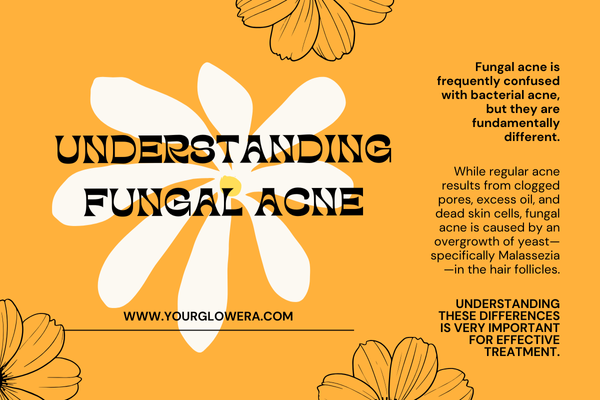
3. Knowing Fungal Acne: Common Signs & Symptoms
How can you determine if your acne is actually fungal? Fungal acne usually presents as small, uniform red or white bumps that often cluster together.
These bumps may be itchy, and the condition commonly occurs in areas that tend to trap moisture, such as the forehead, chest, and back. Another key indicator is the persistence of the bumps despite using traditional acne treatments.
Preventing fungal acne is better than having to treat it, so taking steps to reduce risk factors is recommended as part of your fungal acne skincare routine. Consistently following the right steps can help maintain clear, healthy skin.
4. What Causes Fungal Acne?
This type of acne is primarily caused by an overgrowth of Malassezia yeast on the skin. This yeast thrives in warm, humid environments, making certain lifestyle factors like excessive sweating, wearing tight clothing, or using heavy, oily skincare products potential contributors.
In addition, antibiotics or a compromised immune system can also trigger fungal acne by disrupting the balance of bacteria and yeast on the skin.
5. How to Prevent Fungal Acne?
Preventing fungal acne is better than having to treat it, so taking steps to reduce risk factors is recommended as part of your fungal acne skincare routine.
Here are some steps you can take to prevent fungal acne from developing:
• Stay Dry: After workouts or when you sweat, ensure that you shower promptly and change into dry clothes. Moisture trapped on the skin provides an ideal environment for fungal growth.
• Avoid Tight Clothing: Tight clothing, especially made of non-breathable fabrics like nylon, traps sweat and heat against your skin, increasing the risk of fungal acne.
• Choose the Right Products: Opt for oil-free, lightweight skincare formulations and steer clear of products with heavy, occlusive ingredients that can clog pores and promote yeast overgrowth.
6. Fungal Acne vs. Regular Acne: Key Differences
A common question that comes to mind is whether fungal acne is the same as regular acne. Although both types cause skin bumps, their underlying causes are different. Fungal acne is caused by an overgrowth of yeast, while regular acne is typically caused by clogged pores and bacteria.
Regular acne is caused by clogged pores resulting from excess oil and dead skin cells, whereas fungal acne occurs when Malassezia yeast overgrows inside the hair follicles.
Additionally, fungal acne may not respond to traditional acne treatments, making it more resistant and requiring different approaches for effective management.
7. How to Build a Fungal Acne Skincare Routine
Creating an effective skincare routine for fungal acne requires a carefully designed and thoughtful approach. The goal is to target the yeast overgrowth while maintaining your skin’s health and preventing further breakouts.
Below are the steps to follow for a skincare routine that combats fungal acne.
8. Step 1: Cleanse with a Gentle, Anti-Fungal Cleanser
Start by using a gentle, anti-fungal cleanser that is formulated to fight the yeast responsible for fungal acne. Look for products containing ingredients like zinc pyrithione or sulfur, which help reduce yeast overgrowth and control fungal acne.
Avoid harsh scrubs or cleansers with high alcohol content, as these can irritate your skin and make fungal acne worse. Instead, choose gentle, non-irritating products that complement your fungal acne skincare routine for better results.
Recommended Products:
• Nizoral Anti-Dandruff Shampoo can be safely applied to the face and body to help treat fungal acne.
• CeraVe Hydrating Cleanser, a gentle option for sensitive skin that doesn’t strip the skin’s moisture balance.
9. Step 2: Exfoliate Regularly to Remove Dead Skin Cells
Exfoliating is important to keep your skin smooth and free of dead skin cells that can trap bacteria and yeast. However, when dealing with fungal acne, be sure to use a mild exfoliant that won’t irritate your skin.
Opt for chemical exfoliants such as salicylic acid or lactic acid, which are both gentle and effective in keeping the skin clear without causing inflammation. These can be beneficial additions to your fungal acne skincare routine, helping to maintain smooth, healthy skin.
Recommended Products:
• The Paula’s Choice Skin Perfecting 2% BHA Liquid Exfoliant, ideally includes salicylic acid in it.
• The Ordinary Glycolic Acid 7% Toning Solution (contains lactic acid).
10. Step 3: Use an Anti-Fungal Treatment
Next, add an anti-fungal treatment to your routine. Products containing ketoconazole or clotrimazole are designed to fight fungal growth on the skin and can be key components of your fungal acne skincare routine.
These treatments can be applied directly to the affected areas to help restore balance to your skin’s microbiome and reduce the yeast population. Be sure to carefully follow the instructions to achieve the best results.
Recommended Products:
• Selsun Blue Medicated Shampoo (effective for fungal acne when used as a body wash).
• Lotrimin AF Antifungal Powder Spray (great for treating fungal acne on the body).
11. Step 4: Moisturize with a Non-Comedogenic Moisturizer
Moisturizing is an important part of any skincare routine, even for those with fungal acne. However, it’s crucial to choose a non-comedogenic, lightweight moisturizer that complements your fungal acne skincare routine.
Avoid heavy creams that contain oils like coconut oil, which can aggravate fungal acne. Look for a moisturizer that hydrates without contributing to excess oil production.
Recommended Products:
• Neutrogena Hydro Boost Water Gel (a lightweight, non-comedogenic moisturizer).
• La Roche-Posay Toleriane Double Repair Moisturizer, ideal for sensitive skin.
12. Step 5: Protect Your Skin with Sunscreen
Applying sunscreen is a crucial part of every skincare routine. Even though fungal acne treatments can make your skin more sensitive to the sun, it’s important to protect your skin from UV damage.
When selecting a broad-spectrum sunscreen for your fungal acne skincare routine, opt for an oil-free and non-comedogenic formula. This ensures that the sunscreen won’t clog pores or contribute to the growth of yeast on your skin.
Look for sunscreens that are labeled as “lightweight” or “gel-based” for a more suitable option.
Recommended Products:
• EltaMD UV Clear Broad-Spectrum SPF 46, ideal for acne-prone and sensitive skin.
• Neutrogena Clear Face Sunscreen SPF 55 (designed for acne-prone skin).
13. Best Budget-Friendly Products for Fungal Acne
Fungal acne treatments don’t have to be expensive to be effective. There are many affordable products that can help clear up your skin without breaking the bank.
A well-planned fungal acne skincare routine can provide excellent results without needing high-end products.
Here are a few recommendations that won’t hurt your wallet:
• Cleansers: CeraVe Hydrating Cleanser or Nizoral Anti-Dandruff Shampoo.
• Anti-Fungal Treatments: Selsun Blue or Head & Shoulders Clinical Strength Shampoo.
• Moisturizers: Neutrogena Hydro Boost Water Gel or La Roche-Posay Toleriane Double Repair Face Moisturizer.
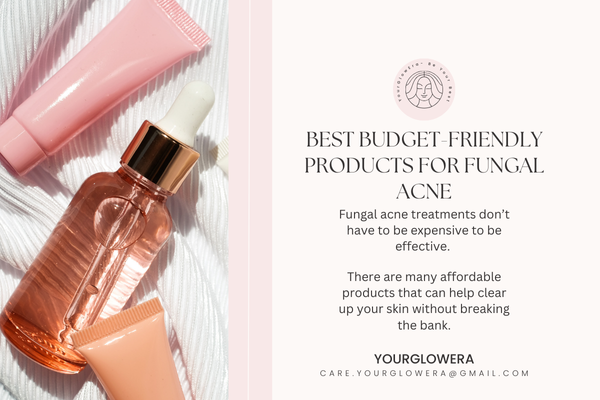
14. Diet and Lifestyle Tips for Fungal Acne Prevention
What you eat and how you live can affect your skin’s health, especially when dealing with fungal acne. Avoid foods high in refined sugars, as they can contribute to the overgrowth of yeast, exacerbating the condition and making it harder to manage through your fungal acne skincare routine.
Additionally, maintaining a balanced diet with plenty of fruits, vegetables, and whole grains can support overall skin health. Staying hydrated and managing stress are also important lifestyle habits that can positively impact your skin while helping to keep fungal acne under control.
15. When to See a Dermatologist for Fungal Acne
If your fungal acne persists despite following a proper skincare routine or if it worsens over time, it’s time to consult a dermatologist.
A professional can provide personalized advice, prescribe stronger treatments if needed, and help identify any underlying factors contributing to the condition. Consulting a dermatologist ensures you’re on the right path to effectively managing and treating fungal acne as part of your comprehensive fungal acne skincare routine.
A professional can prescribe stronger antifungal medications or recommend other treatments to get your skin back on track.
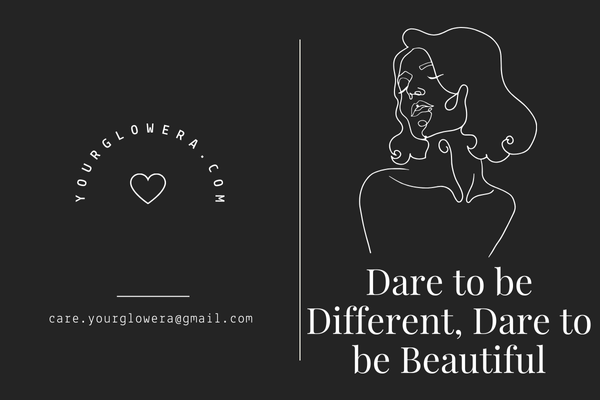
Final Thoughts on Fungal Acne Skincare Routine
A consistent and well-thought-out fungal acne skincare routine is essential for managing and treating fungal acne effectively.
With the right products and lifestyle habits, you can control fungal acne and achieve clear, healthy skin. A well-followed fungal acne skincare routine can help restore balance to your skin and prevent flare-ups.
Remember that patience is key—be consistent with your routine, and give your skin time to heal. By incorporating antifungal ingredients and avoiding products that aggravate the condition, you’ll improve your chances of seeing long-lasting results.
If you’re tired of battling fungal acne and are ready to achieve clear, healthy skin, then look no further! Our guide, “The Ultimate Fungal Acne Skincare Routine: Clear Skin Starts Here!“ is your go-to resource for a step-by-step skincare routine specifically designed to fight fungal acne.
Packed with expert tips, product recommendations, and essential skincare steps, this guide will help you tackle fungal acne and restore balance to your skin. Ready to get started on your journey to clear skin? Check out our ultimate routine and see the difference it can make!
Don’t miss out on these essential tips to tackle fungal acne once and for all. Read on to discover the routine that could transform your skin!
Frequently Asked Questions
1. What kills fungal acne on face?
Antifungal treatments like ketoconazole, clotrimazole, or selenium sulfide can effectively kill the yeast causing fungal acne. Topical antifungal creams, shampoos, and cleansers are popular options.
2. What to avoid in skincare for fungal acne?
Avoid heavy oils, fatty alcohols, and products with a high concentration of emollients. These ingredients can feed the yeast responsible for fungal acne. Avoid using pore-clogging ingredients like silicones.
3. Can salicylic acid remove fungal acne?
Salicylic acid is primarily used for regular acne as it helps with exfoliation and pore-clearing. It’s not specifically antifungal, so it may not directly treat fungal acne, but it can help with other related skin issues.
4. Can I use niacinamide for fungal acne?
Yes! Niacinamide (Vitamin B3) is generally safe and effective for fungal acne. It helps to calm inflammation, regulate sebum production, and improve the skin barrier.
5. What skincare is good for fungal acne?
Skincare with antifungal ingredients like ketoconazole, zinc pyrithione, selenium sulfide, and sulfur are good for fungal acne. Light, oil-free, non-comedogenic products are also essential.
6. How did I clear my fungal acne?
Consistency is key! Using a combination of antifungal treatments (like ketoconazole shampoo), oil-free moisturizers, and gentle cleansers can help clear fungal acne. Avoiding triggers like tight clothing and heavy skincare products also plays a big role.
7. How to remove closed comedones?
Closed comedones (whiteheads) are best treated with gentle exfoliation (chemical exfoliants like salicylic acid), and regular use of non-comedogenic skincare to prevent clogged pores.
8. Which skin cream is best for fungal infection?
Skin creams containing antifungal ingredients like clotrimazole, ketoconazole, and miconazole are best for fungal infections. You can find these in both prescription and over-the-counter options.
9. Is vitamin C good for fungal acne?
Vitamin C may not directly target fungal acne but is beneficial for overall skin health. However, if your fungal acne is sensitive or irritated, vitamin C may cause irritation, so proceed with caution.
10. Is glycolic acid antifungal?
No, glycolic acid is not antifungal. It is an exfoliant used for addressing clogged pores and uneven skin texture. While it helps with acne, it won’t treat fungal acne specifically.
11. What is fungal acne and how do I know if I have it?
Fungal acne, or Malassezia folliculitis, is caused by an overgrowth of yeast on the skin, leading to small, itchy bumps that can resemble regular acne. It often appears on the forehead, chest, back, or shoulders. If your acne doesn’t respond to traditional acne treatments, you might have fungal acne.
12. What are the best ingredients to treat fungal acne?
To treat fungal acne, look for products with antifungal ingredients like ketoconazole, zinc pyrithione, or sulfur. These ingredients target the yeast causing the overgrowth. Avoid oils such as coconut oil and olive oil, as they can feed the fungus and worsen the condition, hindering the effectiveness of your fungal acne skincare routine.
13. Can my regular skincare routine work for fungal acne?
Regular acne products may not work for fungal acne. Many common acne treatments, like those with high oil content, can actually trigger or aggravate fungal acne. It’s essential to use skincare formulated for fungal acne, including non-comedogenic and antifungal ingredients, to ensure your fungal acne skincare routine is effective.
14. How do I differentiate between fungal acne and regular acne?
Fungal acne usually appears as uniform, small bumps that are itchy, while regular acne can present as cysts, blackheads, or whiteheads. Fungal acne tends to be more prevalent on the forehead, chest, and back and might be triggered by heat, sweat, or certain skincare products.
15. How long will it take to clear up fungal acne?
With consistent treatment using the right products, most people see improvement within 2–4 weeks. However, depending on the severity, it may take a little longer. Sticking to a dedicated routine and avoiding triggers is crucial for faster and more effective results.


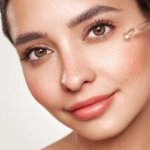
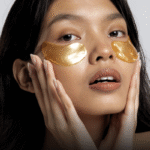




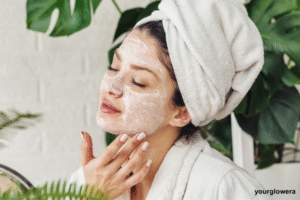
Leave a reply